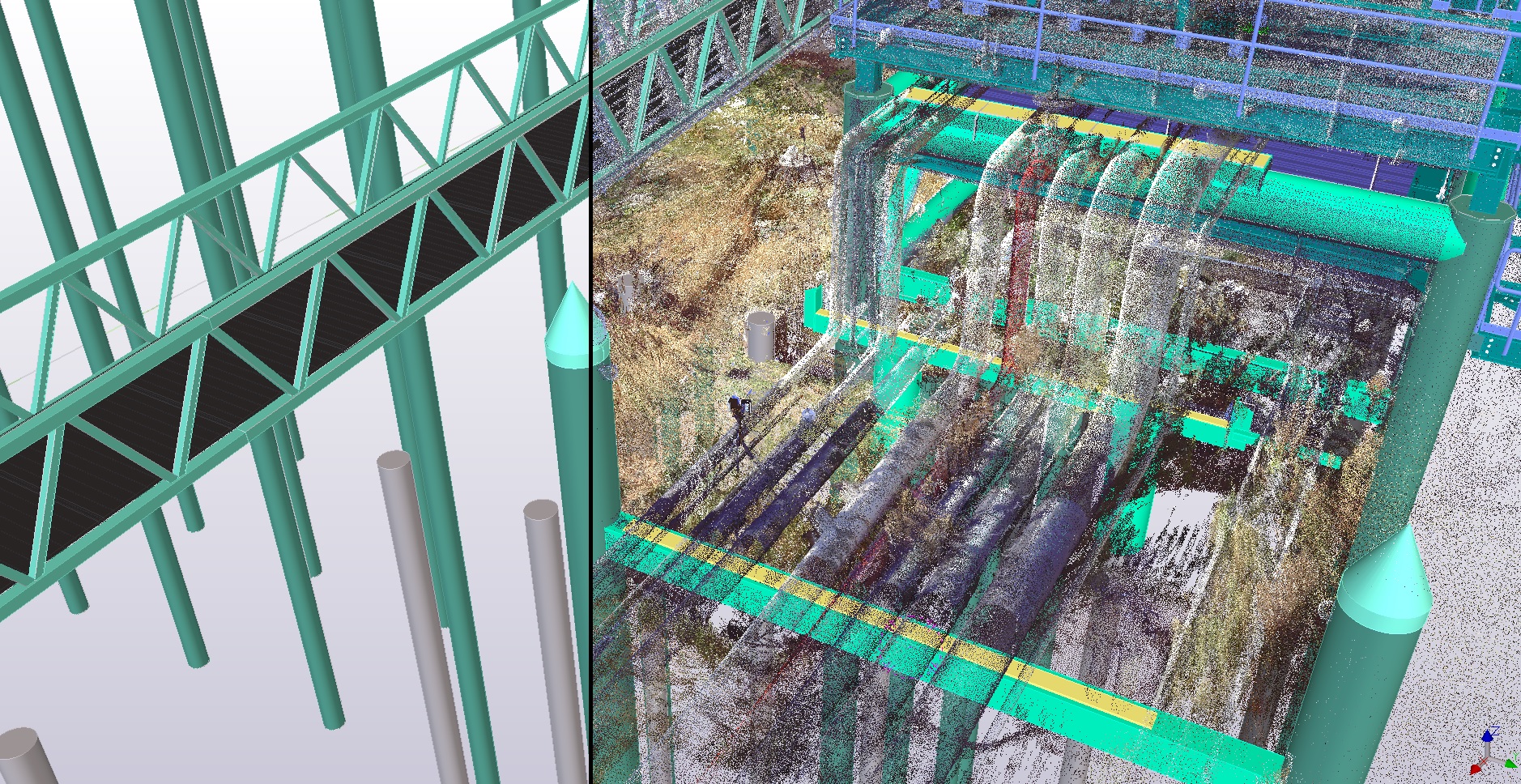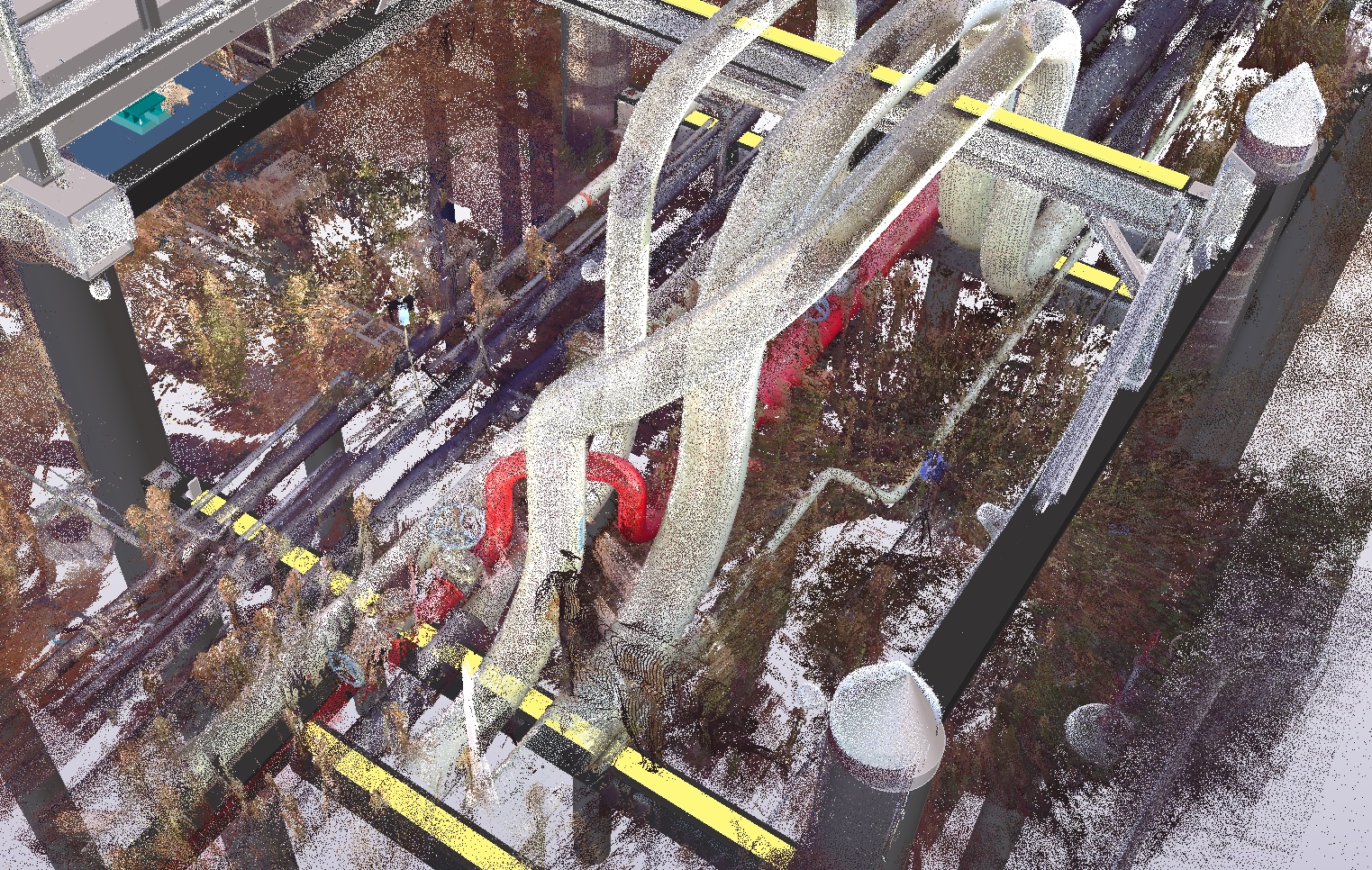Day 14: A Practical Example of Mojo::DOM

With recent versions of Mojolicious, Mojo::DOM gained a lot of power that I have been excited to try, but haven't had the time for. Recently, I had a problem at my real job (in Engineering, Procurement, and Construction, or EPC for short) that I solved with Mojo::DOM (and other parts of Mojolicious) in a very short time – including learning how to use Mojo::DOM, which I had never done before.
The task - simple, but tedious.
3D models and drawings are fantastic tools, but in reality things are not so perfect. Construction tolerances being what they are, our company relies a lot on laser scanning, where we go out to a project site and create a point cloud of the as-built conditions. This generates hundreds of files that take many hours to process - a recent project had over 3 billion individual points. These are critical for engineering, modeling, and construction throughout every project we do.
The problem is when our 3D modeling software (Tekla Structures) processes the point clouds, it changes the file names of each one from something human readable, such as Pipe Rack Area1, to a hash, like 2e9d52829f973c5b98f60935d8a9fa2b. This is not very user friendly when one project could have dozens of areas, and you only really want to load one or two at a time (an average area is 15gb!).
 Point clouds provide critical information that is either too difficult or too costly to model directly
Point clouds provide critical information that is either too difficult or too costly to model directly
Fortunately, Tekla uses a lot of standard file formats that anyone can edit – including using XML to describe each point cloud it has processed. Of course, I could just hand edit them to change the names, but that would have to be done for every scan and every project - not a good solution.
Conveniently, the XML file contains both the hash name and the original file name – so I knew I could use Mojo::DOM to parse the XML and rename the point clouds to be human readable. This simple task is the perfect example of how Mojolicious can accomplish a lot of work with relatively short code. The result is the script below:
#!/usr/bin/perl
use Mojo::Base -strict;
use Mojo::Util qw(getopt);
use Mojo::File;
use Mojo::DOM;
getopt 'p|path=s' => \my $path;
sub main {
# look in xml elements for laserscans that have hashes for names
my $file = Mojo::File->new($path, 'pointclouds.xml');
my $dom = Mojo::DOM->new($file->slurp);
# if 'Hash' is populated, rename_files(); otherwise ignore
for my $e ($dom->find('PointCloudData')->each) {
$e->{Folder} = rename_files($e) and $e->{Hash} = '' if $e->{Hash};
}
# save xml file so we don't try to rename the pointclouds again
$file->spurt($dom);
}
sub rename_files {
# rename pointcloud folder and database file
my $e = shift;
my $newname = $e->{Folder} =~ s/$e->{Hash}/$e->{Name}/r;
say "renaming: $e->{Folder} to:\n$newname";
rename $e->{Folder}, $newname || die $!;
rename $e->{Folder}.'.db', $newname.'.db' || die $!;
return ($newname);
}
main() if $path || die 'Please enter a path to the example files.';
Not a web app
Not every use of Mojolicious has to be a full app - parts of it can be used like any other Perl module. For a simple script, it can make getting to your actual purpose much quicker. I use following line now all the time, even if I'm not building a full Mojolicious app. Mojo::Base saves me from typing additional boiler plate and enables strict, warnings, and other goodies I often want to use.
use Mojo::Base -strict;
Mojo::Util - just for fun
The production version of my utility actually loads a dummy Mojolicious $app so that I can use Mojolicious::Plugin::Config to locate the point cloud files in myapp.conf, but in this version I'm using Mojo::Util to get the point cloud file path with a command line option --p.
getopt 'p|path=s' => \my $path;
To the run my utility on the example files, you must first change the contents of Folder in pointclouds.xml to wherever you've saved them.
$ perl tekla_utility.pl --p 'path to example files'
Mojo::File - never manually write file code again!
Mojo::File makes reading pointclouds.xml so I can parse it with Mojo::DOM simple:
my $file = Mojo::File->new($path, 'pointclouds.xml');
my $dom = Mojo::DOM->new($file->slurp);
In the bad old days, I probably hand wrote 15 lines of (horrible) code every time I wanted to read a file.
Mojo::DOM - what can't it do?
And of course, Mojo::DOM makes finding the right values in the XML easy - it also handles HTML and CSS selectors. Basically, I just iterate through the contents of PointCloudData, which contains the Folder, Hash, and Name keys for each point cloud Tekla has processed:
for my $e ($dom->find('PointCloudData')->each) {
$e->{Folder} = rename_files($e) and $e->{Hash} = '' if $e->{Hash};
}
I only run rename_files if Hash is populated, and if it is, I empty it so I don't try to rename them again. rename_files is about the only Perl code I had to write myself - almost everything else was copied and pasted straight from the excellent Mojolicious docs!
A substitution stores the desired file & folder name in $newname (non-destructive modifier /r allows me to work on a copy of $e without changing the original). Then I simply rename the point cloud folder and the *.db file (which contains the actual point cloud data).
my $newname = $e->{Folder} =~ s/$e->{Hash}/$e->{Name}/r;
When I'm finished renaming the point clouds, I use Mojo::File to save the contents of $dom back to pointclouds.xml with one line:
$file->spurt($dom)
The neat thing is, when I altered the contents of $e->{Folder} and $e->{Hash} in my loop, saving it back just works - I don't need to think too much about the XML structure at all. Interestingly, saving $dom alpabetizes the keys, but Tekla doesn't seem to notice.
 Note the grainy nature of the point cloud - since they are just points with no area, the closer you get, the grainier it looks
Note the grainy nature of the point cloud - since they are just points with no area, the closer you get, the grainier it looks
Useful for all skill levels
This is just one example of how I have used Mojolicious in my day job. Sometimes, existing software doesn't do what you want, or does it in a format that's not useful - problems that can be solved with the many tools Mojolicious provides. You don't even have to be a real programmer (I'm not), or work in the software industry at all.
My next project idea is to rebuild a reporting tool I wrote for Material Take Offs (MTOs) to work with Tekla, which our engineers loved with our old modeling software - and I'm sure I will continue to find good uses for Mojolicious well into the future.
Original screenshots by maschine, released under CC-BY-SA 4.0.

Chris Seigman (maschine)
Chris has been using Perl to develop websites and other tools for more than 20 years, but mostly as a hobby. Since discovering Mojolicious, his Perl skills have improved dramatically, and he has expanded beyond simple CGI scripts to using Mojolicious for everything from large websites to short utilities. His most ambitious project ever, which is a Mojolicious web app - can be found at Bimmerlabs